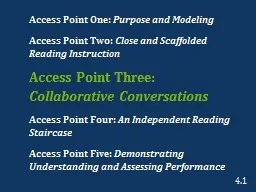

Purpose and Modeling Access Point Two Close and Scaffolded Reading Instruction Access Point Three Collaborative Conversations Access Point Four An Independent Reading Staircase Access Point Five ID: 242066
Download Presentation The PPT/PDF document "Access Point One:" is the property of its rightful owner. Permission is granted to download and print the materials on this web site for personal, non-commercial use only, and to display it on your personal computer provided you do not modify the materials and that you retain all copyright notices contained in the materials. By downloading content from our website, you accept the terms of this agreement.
Slide1
Access Point One: Purpose and ModelingAccess Point Two: Close and Scaffolded Reading InstructionAccess Point Three: Collaborative ConversationsAccess Point Four: An Independent Reading StaircaseAccess Point Five: Demonstrating Understanding and Assessing Performance
4
.
1Slide2
What’s Our Purpose for Module 4?Understand the value and necessity of student peer interaction in collaborative learning. Analyze the differences in grade-level expectations in Speaking and Listening Standard Anchor 1 in CCSS
.
Look closely at the
essential indicators and key elements of collaborative learning structures.Explore the most effective collaborative learning structures to support students in accessing complex texts: literature circlesdiscussion roundtablesreciprocal teaching collaborative strategic reading
4.2Slide3
4.3Is a critical linchpin in the process of assessing complex textsSupports student learning in the absence of the teacher
Provides opportunities
for students to
apply skills and strategies Allows for authentic practice of academic language
Collaborative LearningSlide4
“According to this standard, students have to discuss the complex texts they have been reading. Not only will this aid them in comprehending the text, but it will also provide them with practice in critical thinking,
argumentation
, and
using evidence in their responses.”4.4Frey, N. ,& Fisher, D. (2013). Rigorous Reading: 5 Access Points for Helping Students Comprehend Complex Texts. Thousand Oaks, CA: Corwin .Slide5
Directions for Jigsaw Procedure for Quality Indicators of Task Complexity to Build Strong Structures for Collaborative Learning 1. Work in groups of four or five.2. Each group chooses a different task complexity indicator: Designs that require students to work together (also read introduction after Building Structures for Collaborative Learning)
Structures that elevate academic language
.
Structures that ensure grade-level workDesigns that allow for productive failure3. Read corresponding section in Chapter 4
(5–7 minutes).
4. Write down salient points on chart paper to share with group (5 minutes).
5. Think of your group as the expert learners on this indicator and the larger group (your audience) as the novice learners.
6. Have fun and be creative!
4.
5Slide6
4.6Rethink demanding content with new learning structures. Use language frames to building academic language.Remember that productive failure is good and healthy.Maintain a level of academic rigor.
Consider task complexity and the degree of
student engagement.
Collaborative Learning Quality IndicatorsSlide7
Collaborative Learning Key Elements Post, teach, and revisit norms for interaction.Group students heterogeneously.Have students set goals.Promote individual and group accountability.4.7Slide8
Consider Classroom Collaboration 4.8Slide9
Through collaborations today you probably Reread the text.Talked with group members to analyze and synthesize meaning.Used specialized (academic) language for this content. Isn’t this what we are asking our students to do?Reflect:Did
all your group members contribute to the task?
Did
you contribute to the task? Next session: Access Point Four: Independent Reading Staircase4.9
One
Final Note